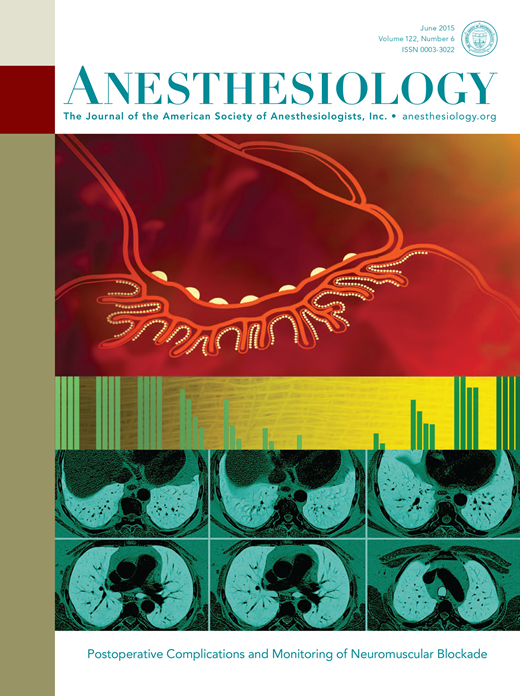Pharmacokinetics and pharmacodynamics of remimazolam for procedural sedation in children and adolescents.
IF 9.1
1区 医学
Q1 ANESTHESIOLOGY
引用次数: 0
Abstract
BACKGROUND/INTRODUCTION Remimazolam is not approved for use in pediatric patients. The pharmacokinetics of remimazolam have been reported to be similar to those of adult patients after scaling for body size. This manuscript reports on the pharmacokinetics and pharmacodynamics of pediatric patients aged ≥6 to ≤18 years and a subsequent model-based optimization of the used dosing regimen. METHODS 31 patients were included in the trial and stratified across four treatment arms: bolus administration, infusion, bolus + fentanyl or infusion + fentanyl. The University of Michigan Sedation Scale (UMSS) was used to assess the depth of sedation. Blood samples were drawn to measure the concentrations of remimazolam and its metabolite CNS7054. Population pharmacokinetic pharmacodynamic modelling was performed in NONMEM ®. RESULTS A population pharmacokinetic model was developed for remimazolam and CNS7054. The elimination clearance of remimazolam was 0.70 L.min -1.70kg -1. A proportional odds model combined with a simplified Minto model described the observed UMSS well. The EC50 of remimazolam for UMSS ≥3 was 777 ng.ml -1 in the absence of fentanyl, and decreased to 655, 533, and 287 ng/ml for concomitant fentanyl steady-state concentrations of 1, 2, or 4 ng.ml -1, respectively. Simulations confirmed that the studied dosing regimen resulted in 9.2 to 22.0% of patients not reaching UMSS ≥3 at the end of the induction. Model-based optimization resulted in higher per kg dosages and the removal of the maximum allowable dose. Simulations indicated that the percentage of patients achieving UMSS ≥3 can be expected to be high (88% to 97%). CONCLUSIONS This study has shown that the pharmacokinetics of remimazolam are likely different between children ≥6 years old and adults (after correcting for size). In addition, the exposure-response relationship shows that to effectively use remimazolam for procedural sedation in children ≥6 years, the dosing regimen should be modified to allow for higher remimazolam exposures.雷马唑仑用于儿童和青少年程序性镇静的药代动力学和药效学。
背景/介绍雷马唑仑未被批准用于儿科患者。据报道,雷马唑仑的药代动力学与按体型计算的成年患者相似。本文报道了年龄≥6岁至≤18岁儿童患者的药代动力学和药效学,以及随后基于模型的给药方案优化。方法将31例患者分为丸给药、输注、丸+芬太尼或输注+芬太尼4个治疗组。采用密歇根大学镇静量表(University of Michigan Sedation Scale, UMSS)评估镇静深度。取血检测雷马唑仑及其代谢物CNS7054的浓度。在NONMEM®中进行群体药代动力学药效学建模。结果建立了雷马唑仑和CNS7054的sa群体药代动力学模型。雷马唑仑的清除清除率为0.70 L.min -1.70kg -1。结合简化Minto模型的比例赔率模型描述了观测到的UMSS井。雷马唑仑对UMSS≥3的EC50为777 ng。在不含芬太尼的情况下,其浓度为-1,当芬太尼的稳态浓度为1、2或4 ng时,其浓度分别降至655,533和287 ng/ Ml。分别是Ml -1。模拟证实,研究的给药方案导致9.2至22.0%的患者在诱导结束时未达到UMSS≥3。基于模型的优化提高了每公斤剂量,并消除了最大允许剂量。模拟表明,达到UMSS≥3的患者比例预计会很高(88%至97%)。结论本研究表明,雷马唑仑的药代动力学在≥6岁的儿童和成人之间可能存在差异(校正尺寸后)。此外,暴露-反应关系表明,为了有效地在≥6岁的儿童中使用雷马唑仑进行程序性镇静,应该修改给药方案,以允许更高的雷马唑仑暴露。
本文章由计算机程序翻译,如有差异,请以英文原文为准。
求助全文
约1分钟内获得全文
求助全文
来源期刊

Anesthesiology
医学-麻醉学
CiteScore
10.40
自引率
5.70%
发文量
542
审稿时长
3-6 weeks
期刊介绍:
With its establishment in 1940, Anesthesiology has emerged as a prominent leader in the field of anesthesiology, encompassing perioperative, critical care, and pain medicine. As the esteemed journal of the American Society of Anesthesiologists, Anesthesiology operates independently with full editorial freedom. Its distinguished Editorial Board, comprising renowned professionals from across the globe, drives the advancement of the specialty by presenting innovative research through immediate open access to select articles and granting free access to all published articles after a six-month period. Furthermore, Anesthesiology actively promotes groundbreaking studies through an influential press release program. The journal's unwavering commitment lies in the dissemination of exemplary work that enhances clinical practice and revolutionizes the practice of medicine within our discipline.
 求助内容:
求助内容: 应助结果提醒方式:
应助结果提醒方式:


